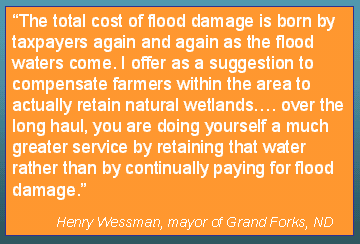Flood Protection
Because of their low topographic position relative to uplands (e.g., isolated depressions, floodplains), wetlands store and slowly release surface water, rain, snowmelt, groundwater and flood waters. Trees and other wetland vegetation also impede the movement of flood waters and distribute them more slowly over floodplains. This combined water storage and slowing action lowers flood heights and reduces erosion downstream and on adjacent lands. It also helps reduce floods and prevents waterlogging of agricultural lands. Wetlands within and downstream of urban areas are particularly valuable in this regard, counteracting the greatly increased rate and volume of surface-water runoff from pavement and buildings.
Preserving and restoring wetlands, together with other water retention, can often provide the level of flood protection otherwise provided by expensive dredging operations and levees. The preservation of wetlands also results in many other benefits to society, such as the protection of ecologically significant fish and wildlife habitat. A good example of this is the Mississippi River's bottomland hardwood-riparian wetlands, which once stored at least 60 days of floodwater and represented significant fish and wildlife habitat. They now store only 12 days of floodwater because most have been filled, leveed, or drained, with substantial loss of fish and wildlife habitat. Another good example is Minnesota, where the cost of replacing the natural flood control function of 5000 acres of drained wetlands was found to be $1.5 million annually.
To quote Henry Wessman, the mayor of Grand Forks, ND: "The total cost of flood damage is born by taxpayers again and again as the flood waters come. I offer as a suggestion to compensate farmers within the area to actually retain natural wetlands. If you look at the costs of compensating farmers for such activities as opposed to the almost annual cost of flood protection and flood fighting within a city such as Grand Forks, you would realize that over the long haul, you are doing yourself a much greater service by retaining that water rather than by continually paying for flood damage."
Therefore, in addition to their fish and wildlife values, wetlands reduce the likelihood of flood damage to homes, businesses, and crops in agricultural areas. They also help control increases in the rate and volume of runoff in urban areas. This protection results in less monetary flood damage (and related insurance costs), as well as protection of human health, safety, and welfare.
![[logo] US EPA](https://www.epa.gov/epafiles/images/logo_epaseal.gif)
